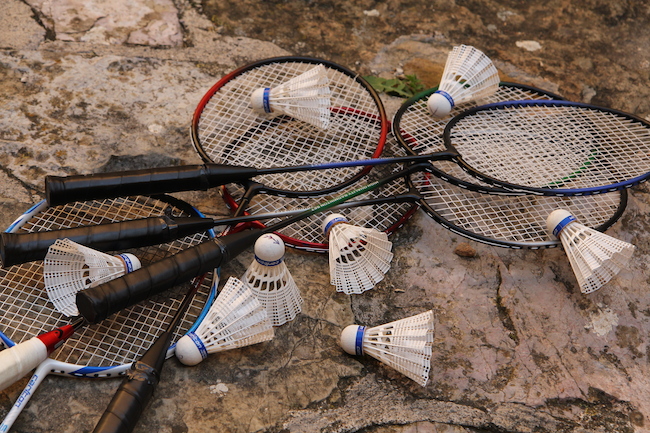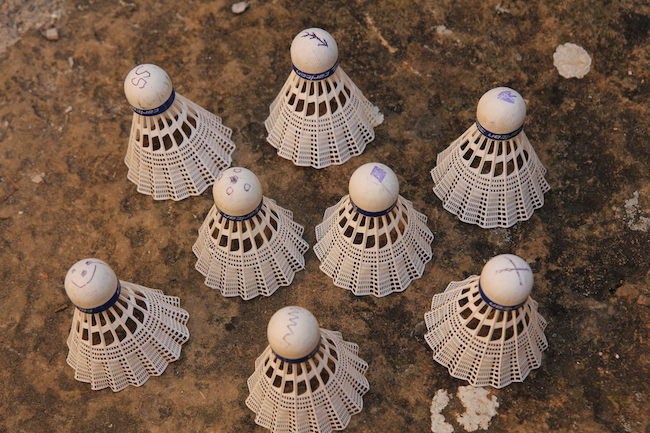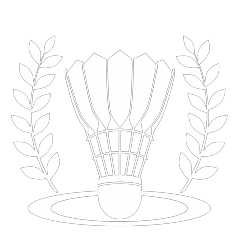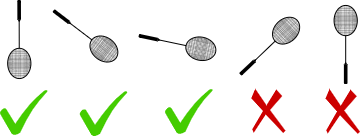Golfington is played with a racquet and shuttlecocks, with multiple players playing the same course in a group and competing against each other to see who can finish it in the fewest shots. Scoring is very similar to golf. Although there is no prescribed number of players in a game, most games are played as a series of foursomes to encourage the social aspect of the game. Some competition games play in twosomes to speed the game up.
The number of holes on a course varies, but most championship level courses will feature between six and nine.

There are three basic rules:
- Aim for the hole in the fewest shots possible
- Hit underarm
- Hit with one foot where the previous shot landed
These are explained here in this informative video:
A fuller explanation:
- A golfington course consists of a number of “holes” set out in a sequence. All players start at the first hole and when they have finished playing it, they move on to the next hole in sequence.
- When hitting the shuttlecock, the shot must be played underarm, with the head of the racquet below its handle. See diagram below.
- The first shot on a hole must played from that hole’s “tee” position, with both feet behind the tee line. Some courses will provide “ladies’ tees” on certain holes; it is entirely up to each player to choose whether or not to use the ladies’ tee should one be available.
- For subsequent shots, at least one foot must be placed exactly where the shuttlecock had landed from the previous shot, except where this is impossible (see rule 5).
- If the shuttlecock lands where it is impossible for the player to place his or her foot due to it landing on an obstacle then the shuttlecock will be placed on the ground in the line of the shot entering the obstacle. There is no penalty incurred for this, unlike when the shot goes out of bounds… see rule 11 and diagram below.
- A hole is finished when all players have hit their shuttlecock into the “hole” target, which will be an area marked on the ground, or on or in an object.
- When each hole is finished players record their scores, i.e. the number of shots that it took them to finish that hole. In competition play there may be an official scorer who takes care of this.
- The game ends when all players have completed all holes in the course. Then each player’s number of shots for all holes are added up and the player with the lowest total number of shots for the whole course is the winner.
- The shuttlecock must be struck with a racquet for each shot and may not be thrown or otherwise moved. Double hits, “push” shots or shots that only hit the feather part of the shuttlecock are not allowed.
- If a player plays a foul shot (e.g. an overarm shot, a double hit or without their feet in the correct position) then the player must replay the shot from the same position and the foul shot will count as a shot on their score.
- On each hole, certain areas may be “out of bounds” and will be indicated as such. If a player hits their shuttlecock into an out of bounds area, they incur a penalty shot and re-take their shot from the point that it entered the out of bounds area. See diagram below.(For golfers: this is less stringent than in golf, where an out of bounds shot would effectively cost two extra shots.) Water is always out of bounds. Beware of falling into the water.
- When aiming for the target (aka “hole”), rules apply as to how to tell whether it is “in”:
- If the target is an actual hole, then the shuttlecock must actually be inside the hole. If it is hanging over the edge but not actually inside, then it is not in.
- If the target is a marked area on the ground, then the whole shuttlecock must be inside the marked area for it to be in. If there is a line or other boundary around the area, then the line counts as part of the target.
- If the target is a raised object, e.g. on top of a table, then as long as the shuttlecock stays on top of the object, it is in (even if some of it is overhanging the edge).
- Any hole can have specific rules that override these.
Diagram for rule 2, showing good underarm (ticked) and bad overarm (crossed) racquet positions:
Diagram for rules 5 and 11. If the the shuttlecock is hit into the grey area which is an obstacle (rule 5) or out of bounds (rule 11) then the next shot should be played from the where the cross is, because that is where it entered the obstacle or out of bounds area.
Players’ shuttlecocks are traditionally marked so that they can be told apart during play, such as these:

The rules have changed very little over the past couple of hundred years, and still remain true to their original ethos. Most recent changes have been small refinements to increase the entertainment factor for modern audiences while retaining the historically captivating gameplay.



